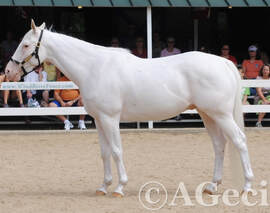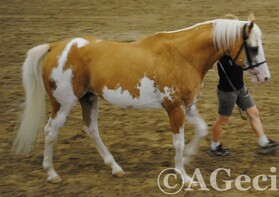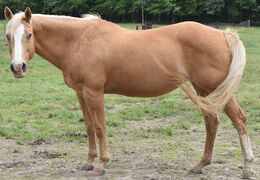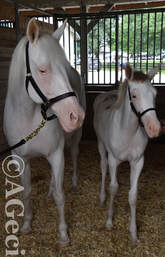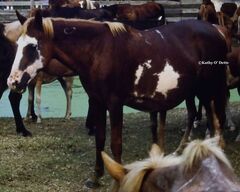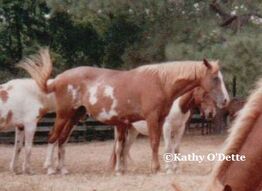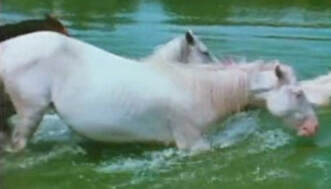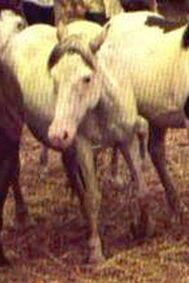Sabino is an often used umbrella descriptive term encompassing the white patterns White Spotting, Dominant White (W), and Sabino1 (SB1). The name of this white pattern group is in dispute, but for now I've put them together under the sabino name. There is a lot of ongoing research and discoveries currently going on in sabino patterns and knowledge is changing rapidly. The only one of this group that has been found in Chincoteagues is White 20. There were other types in the past, including sabino roan.
Sabino is generally characterized by high white, belly spots, all white, wide blazes, "chrome", lacy white spots, body spotting that is not one of the other pinto patterns, and etc.
Sabino is generally characterized by high white, belly spots, all white, wide blazes, "chrome", lacy white spots, body spotting that is not one of the other pinto patterns, and etc.
Sabino, White Spotting, W, or Dominant White is a dominant pinto pattern of which many have been found and there are likely many more. Expression of the W group ranges from a solid white coat, a near white coat, roan appearing sabino, the traditional description of a sabino, and minimally marked. Interactions between multiple sabino patterns can have varied outcomes. White spotting generally has dark eyes, but blue or partially blue eyes are not uncommon. Some of the mutations are homozygous lethals, but many others are not.
Tests for a number of the types of W are available. There are likely many more types of white spotting, so many they will likely never all be found. The sabino group patterns are usually found on the KIT gene. KIT is well known to mutate frequently which results in new white patterns. The current known W group patterns with the founding breed:
|
W1 Freiberger
W2 Thoroughbred W3 Arabian W4 Camarillo White Horse W5 Thoroughbred W6 Thoroughbred W7 Thoroughbred W8 Icelandic W9 Holsteiner W10 Quarter Horse W11 South German Coldblood W12 Thoroughbred W13 Multiple Breeds W14 Thoroughbred W15 Arabian W16 Oldenburg W17 Japanese Draft Horse W18 Swiss Warmblood W19 Arabian W20 Found in many breeds including Chincoteagues W21 Icelandic W22 Thoroughbred W23 Arabian W24 Standardbred W25 Thoroughbred W26 Thoroughbred W27 Thoroughbred W28 German Riding Pony W30 Berber W31 Quarter Horse W32 Paint Horse W33 Standardbred W34 Found in many breeds W35 Quarter Horse |
Sabino 1 (SB1) is an incomplete dominant that is not found in Chincoteague Ponies. There are also white patterns in multiple breeds that fit the umbrella description of sabino that have not yet been found.
It's unknown when W20 or any other version of sabino was introduced into Chincoteagues. The early ponies had minimal markings so W20 or other minimal types may have been present originally. Or it may have been introduced through the same or similar outcrossing that brought in the other pinto patterns. It's possible a new W mutation could occur or has occurred in Chincoteagues like it has in many other breeds.

